Trumpetflower or trumpet flower may refer to several plants:

Collomia is a genus of flowering plants in the family Polemoniaceae. Species in the genus are known generally as trumpets, mountain trumpets, or trumpet flowers. They are native to North America and southern South America. The genus name comes from the Greek kolla ("glue"), a reference to the seeds, which become gelatinous in texture when wet.
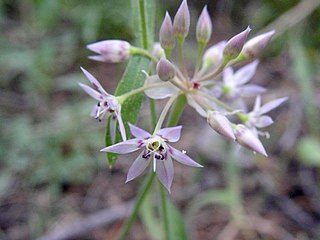
Allium campanulatum is a species of wild onion known by the common name dusky onion or Sierra onion. This is a flowering plant native to the western United States from southeastern Washington and northern Oregon to southern California, and western Nevada. The dusky onion grows in foothills and mountains, especially in dry areas, such as chaparral habitats.

Collomia grandiflora is a western North American annual plant in the phlox family (Polemoniaceae), known by the common names grand collomia, large-flowered mountain trumpet, and large-flowered collomia. It usually appears in sandy habitats and is cultivated as an ornamental.

Collomia linearis is a species of flowering plant in the phlox family known by the common names tiny trumpet and slenderleaf collomia. This tiny wildflower is native to North America where it is fairly widespread across the north and west. It is an annual herb, rarely exceeding 30 centimetres (12 in) in height, with a velvety erect stem bearing long, narrow green leaves. Atop the stem is a cluster of up to 20 white or light pink flowers, each about a centimeter across. Each has five small rounded petals and stamens tipped with anthers bearing white pollen.
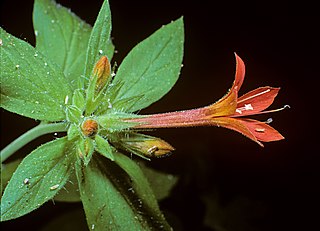
Collomia rawsoniana is a species of flowering plant in the phlox family known by the common name flaming trumpet. This perennial wildflower is endemic to California, where it is known from only two counties: Mariposa and Madera. It grows in the woodland understory in the Sierra Nevada foothills. This plant produces a thin, erect stem to about half a meter in height with widely spaced, deeply toothed hairy leaves each several centimeters long. Atop the stem is an inflorescence of three to seven showy red-orange flowers. Each flower is up to 4 centimeters long and trumpet-shaped, with a protruding pistil and stamens tipped with anthers covered in blue pollen.
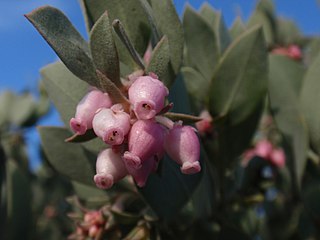
Arctostaphylos canescens, common name hoary manzanita, is a species of manzanita.

Arctostaphylos regismontana is a species of manzanita known by the common name Kings Mountain manzanita. It is endemic to California, where it is known from the northern slopes of the Santa Cruz Mountains in the southern San Francisco Bay Area.
Astragalus funereus is an uncommon species of milkvetch known by the common names Funeral Mountain milkvetch and black milkvetch.

Astragalus jaegerianus is a rare species of milkvetch known by the common name Lane Mountain milkvetch. The plant was named for the biologist Edmund Jaeger, who first documented it in 1939.
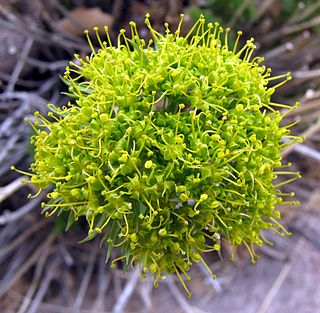
Lomatium parryi, commonly known as Parry's biscuitroot and Utah desertparsley, is a perennial herb in the carrot family. It is a common herb in high altitude areas of deserts and common in desert National parks, such as Death Valley mountains, in the western part of the United States.

Collomia diversifolia is a species of flowering plant in the phlox family known by the common name serpentine collomia. It is endemic to California, where it is an uncommon member of the serpentine soils flora in the North Coast Ranges from the northern San Francisco Bay Area to Shasta County. It is a small annual herb with many branches bearing dark, slightly hairy, lance-shaped leaves, the most basal ones having three small teeth. The inflorescence is a cluster of several flowers each about a centimeter wide. The star-shaped flower has pointed violet lobes with yellowish bases coming together at a purple throat.

Collomia heterophylla is a species of flowering plant in the phlox family known by the common name variableleaf collomia. It is native to western North America from British Columbia to Idaho to central California, where it grows in several types of habitat, including open areas on gravelly mountain slopes. It is a hairy annual herb producing a branching, erect stem. As the common name suggests, the leaves are variable in shape, the lower generally with several toothed lobes and the upper sometimes lacking lobes. The inflorescence is a cluster of flowers emerging from the top of the stem or from the axil of a leaf. It may bear up to 25 flowers, each with star-shaped corolla at the tip of an elongated tube. The corolla lobes are lance-shaped and white to deep pink with white bases.
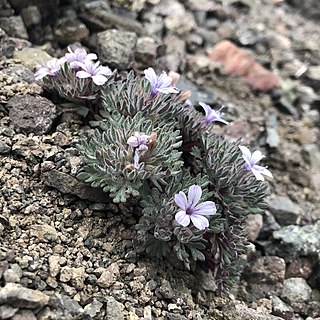
Collomia larsenii is a species of flowering plant in the phlox family known by the common name talus collomia. It is native to the Olympic Mountains of Washington and the Cascade Range from Washington to northern California, where it grows in high exposed mountainside talus. It is a perennial herb forming a clump in the volcanic rocks. The branching stem is covered in fleshy, glandular, hairy leaves, each divided into many lobes. The inflorescence is a cluster of 6 to 9 tubular purple flowers, each with a face up to 1.5 centimeters wide.

Collomia tinctoria is a species of flowering plant in the phlox family known by the common name staining collomia. It is native to the western United States from Washington to Montana to California, where it grows in open, rocky habitat in mountains. It is an annual herb producing a slender, branched stem no taller than about 8 centimeters. The glandular, hairy leaves are lance-shaped. The inflorescence is composed of two or three flowers emerging from the leaf axils. Each flower has pointed sepals tipped with awns. The flower has a purplish tube and a pinkish corolla.

Penstemon laetus is a species of penstemon known by the common names mountain blue penstemon and gay penstemon. It is native to the inland mountains of Oregon and California, where its distribution extends from the Klamath Mountains through the Sierra Nevada to the Transverse Ranges. It grows in forest, scrub, and other local mountain habitat. It is a perennial herb growing erect to about 75 centimeters tall, its base becoming woody. The leaves are linear to lance-shaped and up to 10 centimeters long. The glandular inflorescence bears blue or purple flowers up to 3.5 centimeters long. The wide-mouthed tubular or funnel-shaped flower is glandular on the outer surface and mostly hairless on the inside.

Raillardella argentea is a species of flowering plant in the family Asteraceae known by the common name silky raillardella. It is native to the Sierra Nevada and nearby mountain ranges of California, its distribution extending east into Nevada and north along the Cascade Range and Klamath Mountains into Oregon. It grows in many types of dry, open mountain habitat. It is a rhizomatous perennial herb growing in a clump of rosetted basal leaves. The leaves are lance-shaped, up to 8 centimeters long, and coated in silky hairs. The plant produces an inflorescence up to about 15 centimeters tall consisting of a solitary flower head which is cylindrical to somewhat bell-shaped. The head is enclosed in the fused outer scales of the flowers, which look similar to the phyllaries of many other species' flower heads. The head contains many yellow disc florets up to a centimeter long each, and no ray florets. The fruit is a long, narrow achene which may be 2 centimeters in length including its plumelike pappus.

Ribes montigenum is a species of currant known by the common names mountain gooseberry, alpine prickly currant, western prickly gooseberry, and gooseberry currant. It is native to western North America from Washington south to California and east as far as the Rocky Mountains, where it grows in high mountain habitat types in subalpine and alpine climates, such as forests and talus. It is a spreading shrub growing up to 1.5 meters tall, the branching stems covered in prickles and hairs and bearing 1 to 5 sharp spines at intervals.

Arctostaphylos gabilanensis is a rare species of manzanita known by the common name Gabilan manzanita.

















